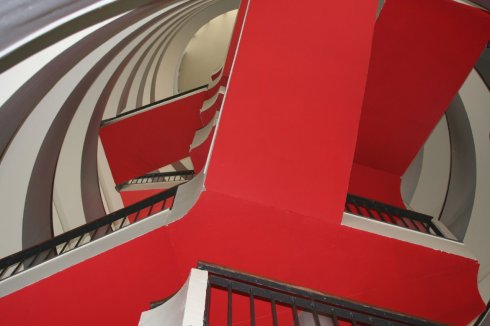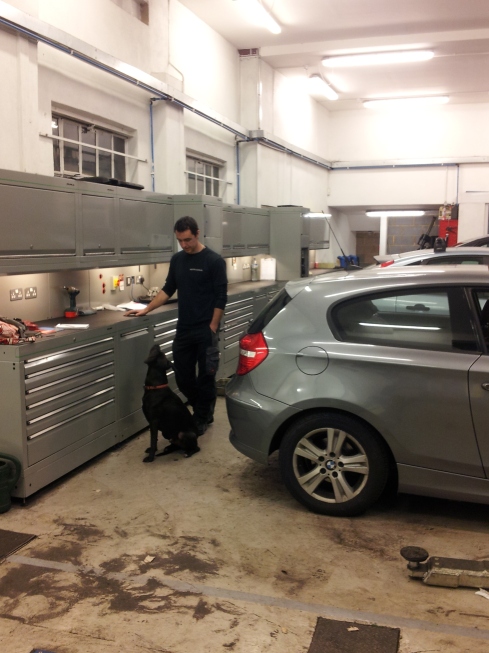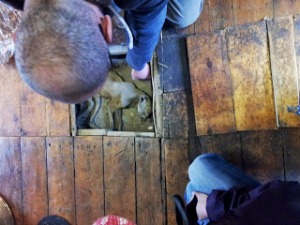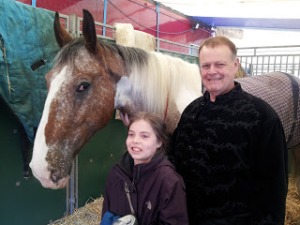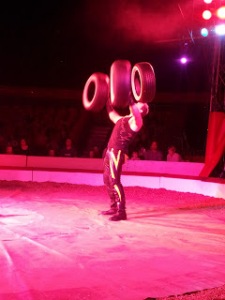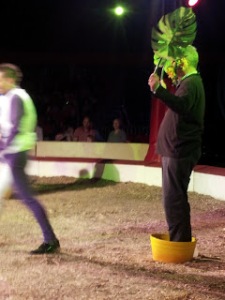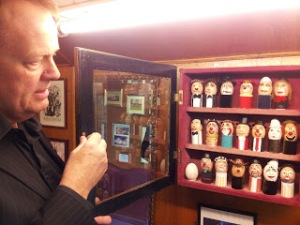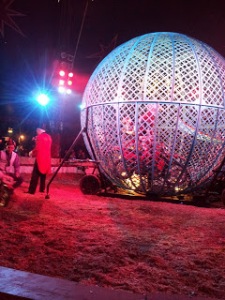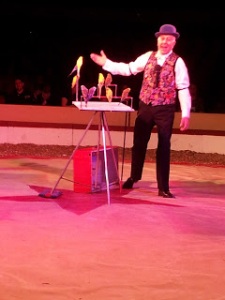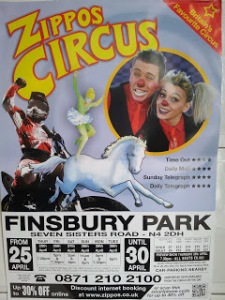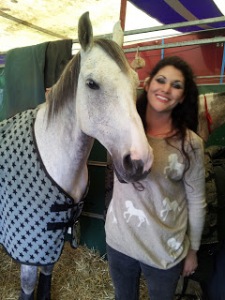Everyone on Islington Faces Blog has a story. Any idea what you do if you want to find out more about your Islington roots – either your family or the places you know in the borough? Or maybe you want to know more about Tufnell Park, Clerkenwell or the people who’ve lived in Islington like Joe Orton or find out who is buried here? If you’re curious about the old Islington then try booking an appointment at the Islington Local History Centre, where there’s a good chance you’ll meet enthusiastic Mark Aston who is in charge of Islington’s local history. Interview by Nicola Baird

“This isn’t a crusty museum,” says Mark Aston who runs Islington Museum and Local History Centre. “I’m keen to get more popular culture into this museum – sport, music and literature – because there’s history in everything.”
Mark Aston lives in Camden but he knows Islington better than most. It’s not just his job as Islington Museum and Local History Centre manager – it’s also because he walks to work at St John’s Road, where Finsbury Library and the museum and local history centre are based. He’s well qualified, with a BSc in IT and librarianship and then an MA in Victorian studies; plus his passion for the area, especially Clerkenwell Green. “The last 20 years I’ve been working in local history,” explains Mark, who is in his early 50s. He enjoys the museum’s collection – his favourite items are the book covers wittily defaced by Joe Orton and Kenneth Halliwell (see photo below) – but admits that his own “house is full of books, old maps of the local area and Victorian photographs. And my wife, well she’s a history graduate, and therefore sympathetic.
Just 3 things to do in Islington by Mark Aston
-
I walk a lot around the area If I go to the Town Hall, Central Library or North Library (off Manor Gardens), I’ll always take photos of roads. I take the sign for context, then a long shot north and south, and after that random pictures of things that catch your attention. In 20-50 years time even a new build of houses or flat conversions will be historic. Remember, just 20 years ago is last century!
-
I particularly like the borough’s music venues – The O2 Academy in N1 and The Garage at Highbury Corner.
-
Come and find out about the animals in the borough since the 17th century at our Beastly Islington exhibition at the Islington Museum, which runs until 30 September. There are lots of free events.
“Islington is very much a people’s borough,” he explains telling me about how the south has medieval roots and the north is a bit younger – developed as London expanded. “I’d like to find out more about places like Tufnell Park. There must be some great stories to be discovered,” says Mark, “it’s a relatively newish area, now about 130 years old and mostly residential.”
This remark rather proves Mark’s appetite for local history. He reminds me that in 1901 there were nearly half a million people in what is now the area we call Islington. Between Angel and Archway there were approximately 335,000 and in the south there were 110,000.
In comparison 2014 Islington is a borough of around 210,000 people.

Mark Aston: Islington Museum and Local History Centre Manager: “Whenever I’ve moved I’ve wanted to find out about the area. For example Joe Orton and Kenneth Halliwell were only in the borough for 15 years but created a cult. They defaced book covers 50 years ago but they are still attracting interest. It’s a way into a local library collection. One of the pieces they defaced I had to bid for as it was filmed by the BBC’s Flog It programme. I was a bit nervous with the camera up my nose, but Orton and Halliwell get the youngsters in!”
Places to look at twice in Islington – Clerkenwell – recommended by Mark Aston
-
There’s such a timeline of history at Clerkenwell Green. I never get bored of going for a walk around it at lunch time. There are lots of nooks and crannies and a 360 degree turn gives you the Marx Memorial Library which predates the court across the road. There’s the hugely popular Crown Pub and St James’s church, which dates from 1792 when it replaced an older chapel which dated back to the 12th century.
-
Have a look at the Clerks’ Well (after which Clerkenwell is named). It’s like a static time machine. The River Fleet used to flow through here and the parish clerks (who were a minor order of religious workers) would perform religious plays by it.
-
During the 1381 peasants’ revolt Watt Tyler and Jack Straw met in Clerkenwell before burning down the monastery of the Order of the Knights of St John. These monks were the medical arm of the Knights Templar and it’s where St John’s Ambulance takes its name.
-
Have a look for the sites of gin factories – both Booths and Gordon’s distilled on Clerkenwell Road.

Notable Islington residents – now in metal – wait outside Finsbury Park tube station by a bench in Station Place. Edith Garrud, who taught suffragettes jujitsu, is the sculpture on the right.
Islington people
“Islington doesn’t have many fancy old iconic buildings – they are mainly in the city of London,” he explains. “It’s people that make the borough! And look at the artists that lived here and the radical politics! Lenin was here, and Stalin. George Fox, the founder of the Quaker movement, is buried in Bunhill Fields burial ground, Islington, which also has Daniel Defoe and William Blake as ‘permanent’ residents. Mary Wollstonecraft was at Newington Green (the mother of Mary Shelley who wrote Frankenstein), and one of my favourites, Edith Garrud a suffragette, an Islington resident who taught jujitsu to protect fellow suffragettes. There’s a plaque to her in Thornhill Square, as well as being featured in a special portrait bench in Finsbury Park at the bus station…”
It’s clear Mark could talk about famous Islington people for a long time.
Turns out he “feels like an honorary Islingtonian and Finsburyite” after researching his own family history in a bid to better understand what the local history centre clients needed. “People meet their cousins – or other family members for the first time – sometimes at the Local History Centre,” he says with some awe.
In fact Mark has proper London roots. “My ancestors were born in Finsbury, the Clerkenwell area and Islington. My great-great-great grandfather – that’s the mid-19th century – was a train driver. And my great, great grandmother was born in Berry Street, Clerkenwell. She married a German immigrant in 1858, from Berlin, at St Clement’s and St Barnabus’s Church in King’s Square and then moved to a house almost where this library is (Coburg Street), which was swept away in the post war re-development.”
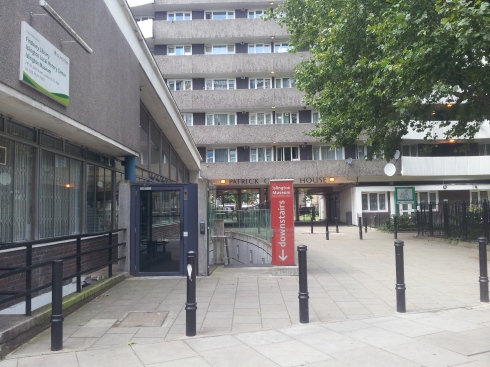
Follow the arrow on the red sign and you’ll be at Islington Museum & Local History Centre. It’s a 10 minute walk from Angel tube, or try bus 153. Farringdon station is quite close too.
It’s always interesting finding out why people want to know stuff about long dead relatives, but Mark understands the compulsion.
“There’s a need to do it, it gives you a sense of place. And people make a place. As you get older you spend more time looking back than forward and want to know where did I come from? What are my roots? What did my ancestors do?” The good news is that Mark thinks “it has never been so easy to trace your family history – there are on line resources, TV guides, like Who Do You Think You Are, and antique shows. There’s also great work from people at the Islington Archaeological and Historical Society.”
The museum gets at least 15,000 visitors a year including many school parties. “The trick is to share an object that has a story – and then to ask ‘what would we use today that this used to be used for?’” explains Mark. The tactic seems to be working as he’s found that ”when kids come in to the museum with school they tend to come back with their parents.”
Mark’s excellent storytelling makes me want to have another look around Islington’s museum. It’s a really interesting collection – a mix of objects and stories that help brings long dead Islington people to life. The museum helped me get a better grip on the huge sweep of history that’s happened here in Islington, and then share the info with my own family. I’m happy to tell you that this was a great success – especially when I added a jujitsu move as taught by Edith Garrud. I’m certain Mark would agree that martial arts definitely have a place at a modern museum.
If this interview has inspired you to find out more about your roots then very good luck finding out more about your family or the people who’ve lived in the places you now know well. And a thank you to Mark Aston for making it a little bit easier for us all.
- Islington Museum is by Finsbury Library, 245 St John Street, EC1. It’s an easy 10 minute walk from Angel station. Open Monday – Saturday 10am-5pm. Closed on Wednesdays and Sundays, www.islington.gov.uk/heritage
- Islington Local History Centre is open 9.30am-8pm Monday and Thursday; and 9.30am-5pm on Tuesday, Friday and Saturday. It is closed daily for lunch (1-2pm) and also closed all day on Wednesday and Sundays. To book a place in the search room and for visitor information call 020 7527 7988 or email local.history@islington.gov.uk
- Info about past exhibitions at http://www.islington.gov.uk/islington/history-heritage/heritage_whatson/wo_exhibition/Pages/pastexhibitions.aspx
- Islington Museum “accepts meaningful objects and materials, and appreciates having first refusal.” It’s particularly keen to add to its historic photographic and illustrations collection. The collection has lots of photos of Upper Street, Holloway Road and Pentonville Road but not the smaller roads… Could you help?
- Mark Aston is the author of Foul Deeds & Suspicious Deaths in Hampstead, Holborn and St Pancras. His other books include Cinemas of Camden and King’s Cross: a tour in time.
Over to you
Would you like to nominate someone to be interviewed? Or would you like to write a guest post for this blog? if the answer is yes for either please email nicolabaird.green@gmail.com
If you’d like to feature on this blog, or make a suggestion about anyone who grew up, lives or works in Islington please let me know, via nicolabaird.green@gmail.com. Thank you.
If you liked this interview please SHARE on twitter or Facebook. Even better follow islingtonfacesblog.com (see menu top right), @nicolabairduk
This blog is inspired by Spitalfields Life written by the Gentle Author.
If you enjoyed this post you might like to look at the A-Z index, or search by interviewee’s roles or jobs to find friends, neighbours and inspiration. Thanks for stopping by. Nicola









